Hot cracking susceptibility research in BTW1 austenitic high-manganese wear-resistant steel
Research Institute,Baoshan Iron & Steel Co.,Ltd.,Shanghai 201999,China
Abstract: Baosteel’s first BTW1 austenitic high-manganese wear-resistant steel exhibits strong deformation-induced hardening characteristics.Compared with common low-alloy martensitic wear-resistant steels in the market,it has improved impact wear resistance,hard abrasive wear,erosion wear performance,and impact toughness.The metallurgical properties of such austenitic wear-resistant steel lead to the risk of failure because of hot cracking defects in the welded structure.In wear-resistant applications,evaluating hot cracking susceptibility is necessary to avoid the effect of welding defects.In this study,the Varestraint test is used to quantitatively analyze and evaluate the hot cracking susceptibility of BTW1 austenitic high-manganese wear-resistant steel.The test results show that by controlling the content of impurity elements and grain refinement,BTW1 austenitic high-manganese wear-resistant steel effectively reduces hot cracking tendency and has a low incidence of hot cracking under small strain conditions.The developed matching welding process can effectively avoid the influence of hot cracking susceptibility.
Key words: BTW1 austenitic high-manganese wear-resistant steel; Varestraint test;hot cracking; hot cracking susceptibility; thermal crack-susceptible region
1 Introduction
Wear-resistant steel products can be widely used in wear-resistant applications such as scraper convey-ors,mining crushing machinery,pipelines,engineer-ing vehicles,and excavators.The most widely used low- and medium-alloy wear-resistant steels in the world are martensitic bainite-reinforced wear-resis-tant plates,including the HARDOX series of wear-resistant steels produced by SSAB OXELOSUND of Sweden and the 400-V and 500-V series of wear-re-sistant steels from Dillingen of Germany,XAR400,XAR450,and XAR500 series wear-resistant steel from ThyssenKrupp of Germany;EH360,EH400,and EH500 series wear-resistant steel from JFE of Japan;NM and B-HARD series wear-resistant steel deve-loped and produced by Wuyang Iron & Steel Co.,Ltd.and Baoshan Iron & Steel Co.,Ltd.of China.Low- and medium-alloy wear-resistant steels rely on high strength to obtain high wear resistance and generally have relatively good impact toughness.However,when they are used for long periods under the dual conditions of impact and wear,they are prone to fatigue cracking,and their service life is significantly reduced.In addition,because these types of wear-resistant steels generally use fusion welding,the toughness and plastic reserve margin of the weld and heat-affected zone (HAZ) are low.On one hand,in the zone of the weld roots,the fusion zone,and the overheating of the welded joints of medium and thick plates,there is a hydrogen-induced delayed cracking tendency.On the other hand,welding workpieces of low- and medium-alloy wear-resistant steels must be preheated before welding and slowly cooled after welding,and post-weld hydrogen elimination treatment should be applied to avoid cold cracks in welded joints of wear-resistant steels.The preheating and post-weld heat treatment has significantly increased production costs and cycles.Furthermore,it has also led to harsh construction conditions and a significant increase in the difficulty of on-site welding,which is unconducive to the improvement of the quality and stability of wear-resistant steel welding.
Another type of austenitic wear-resistant steel,denoted by Mn13,has good adaptability under the action of strong impact and high-pressure material wear.Using the deformation strengthening mech-anism,Mn13 is used in ball mill liners,excavator teeth,crusher tooth plates,and low-impact castings that require wear resistance,such as liners,tooth plates,broken walls,and rolling mortar walls.It is widely used in roller sleeves and shovel teeth[1-2].Due to the high manganese and carbon content,carbides at the grain boundaries of the welded joints of this type of high-manganese wear-resistant steel plate tend to precipitate,resulting in welding seams and HAZs that are prone to welding hot cracking,poor weldability,and narrow welding process windows.The great difficulty of welding limits the application of this type of high-manganese wear-resistant steel[3-5].
Baosteel’s first improved high-manganese wear-resistant steel BTW1 has a deformation-induced hardening characteristic that exceeds that of high-manganese steels such as Mn13 and Mn18.Under the wear condition of 600-N quartz sand,the wear resistance of BTW1 wear-resistant steel is 91% higher than that of HARDOX450.The development of this austenitic high-manganese steel meets the individual and serial requirements of wear-resistant steel products for mining machinery and comprehen-sively enhances the competitiveness of high-mang-anese wear-resistant steel products.BTW1 austenitic high-manganese wear-resistant steel engineering applications use several welded structures,and the single austenite structure of the base material makes this type of material susceptible to hot cracking.There are few studies on the hot cracking suscep-tibility of high-manganese steel welding at home and abroad,which restricts the application of this kind of wear-resistant steel welding structure.Hot cracking is a relatively common type of crack defect in welding production.It occurs during the welding process when the weld and HAZ metal is cooled to a high-temperature zone near the solidus.It is mainly divided into crystallization cracks,liquation cracks,and polygonal cracks.In this study,a com-bination of Varestraint test and numerical simulation calculation of welding temperature fields is used to evaluate the HAZ liquation cracking susceptibility in BTW1 austenitic high-manganese wear-resistant steel,and through quantitative analysis of such hot cracking susceptibility,obtain the metallurgical parameters of the material,support the development of new high-manganese steel welding process and the optimization of welding structure performance,and meet the needs of industry users for welded joint performance and on-site manufacturing charac-teristics.
2 Test materials and test methods
2.1 Test materials
The BTW1 austenitic high-manganese wear-resis-tant steel plate developed by Baosteel was used as the base metal for the test.The chemical composition of the base metal is shown in Table 1,and its microstructure is shown in Fig.1.The test plate thickness of the Varestraint test is 6 mm,and the mechanical properties of the test plate are shown in Table 2.

Table 1 Chemical composition of the base metal %
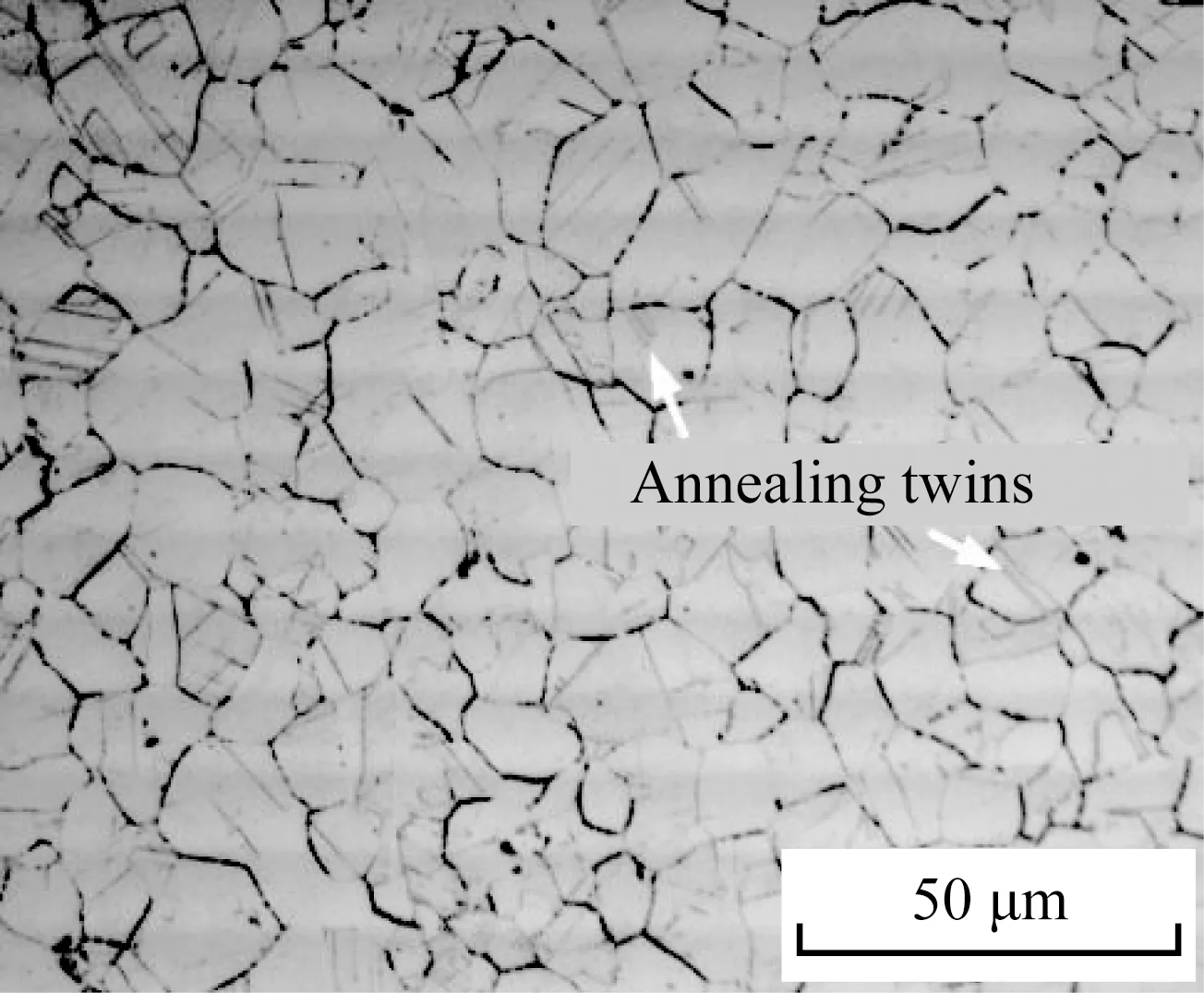
Fig.1 Microstructure of the base metal

Table 2 Mechanical properties of the base metal
2.2 Varestraint test
The evaluation of hot cracking susceptibility test techniques such as the circular patch test,Varestraint test,and hot ductility test have been developed to quantify hot cracking susceptibility.The circular patch test is ineffective in quantifying weldability among different materials due to diffi-culties in isolating the material factor from test results.This test technique only provides a simple “crack or no crack” solution for a specific material.Data such as the cracking temperature range,cracking stress,and strain cannot be obtained.While the hot ductility test only measures the strength and ductility of a material at high temperatures,both test techniques have limitations[6-8].At present,the Varestraint test is recognized as one of the most effective and intuitive techniques for assessing hot cracking susceptibility.This test is designed as a simple strain-type test that can characterize the metallurgical variable that causes hot cracking.The Varestraint test can quantify hot cracking susceptibility.This methodology characterizes a thermal crack-susceptible region (CSR),effectively supports the selection of materials,and optimizes the welding structure.
Aiming at the single austenite characteristics of the BTW1 base metal,the longitudinal Varestraint test is used in this study to study hot cracking susceptibility,which has a significant impact on the safety of the welded structure.Under the action of the welding thermal cycle,the weld metal of austenitic material may form solidification cracks,and in addition,hot cracking dominated by liquation cracking is formed in the HAZ.For these two hot cracking types generated during welding,hot cracking susceptibility research can quantitatively characterize the weldability of materials,which is helpful for material application and optimization of welded structure performance.During the test,the two ends of the test plate are fixed above the supporting roller by the loading roller,and then the tungsten inert gas (TIG) arc is used to remelt the test plate from pointsAtoC.When the arc moves to pointB,the device loads the loading roller,causing the test plate to bend quickly at a certain speed until the test plate is fully fitted on a radiused die block with a radius of curvature.The schematic of the test is shown in Fig.2.The arc continues to advance after bending at pointBuntil the arc stops at pointC.During the test,the bending moment was applied along the length of the weld bead,and cracks were generated in the weld beam and the adjacent HAZ.Hot cracking occurs at the fusion boundary of the molten pool and expands along liquid films at grain boundaries toward the HAZ.The test equipment used in this study is the MTV2500 Varestraint test machine produced by D.L.WRIGHT Company in the United States,as shown in Fig.3.In the Varestraint test,the strain applied at pointBof the test plate is controlled by a replaceable block.Unlike the traditional Varestraint test,the MTV2500 testing machine uses a radiused die block with different radii to achieve different strains.This equipment can perform a variety of tests,has a simple sample preparation process,is easy to use,and produces consistent data.
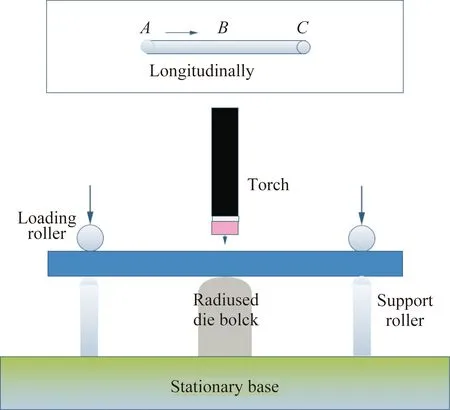
Fig.2 Schematic of Varestraint test
The strain (ε) on the test plate can be calculated by Equation (1):
(1)
where,trepresents the thickness of the test plate;andRrepresents the radius of the die block.
In the Varestraint test,a microscope (20-50×) is used to measure the crack length on the surface of the sample after the test.The maximum crack length (MCL),which is observed on the surface of the sample,is used as a measurement parameter.The thermal CSR corresponding to the maximum crack propagation path is used to quantitatively evaluate hot cracking susceptibility.CSR reflects the difference in the metallurgical properties of materials.
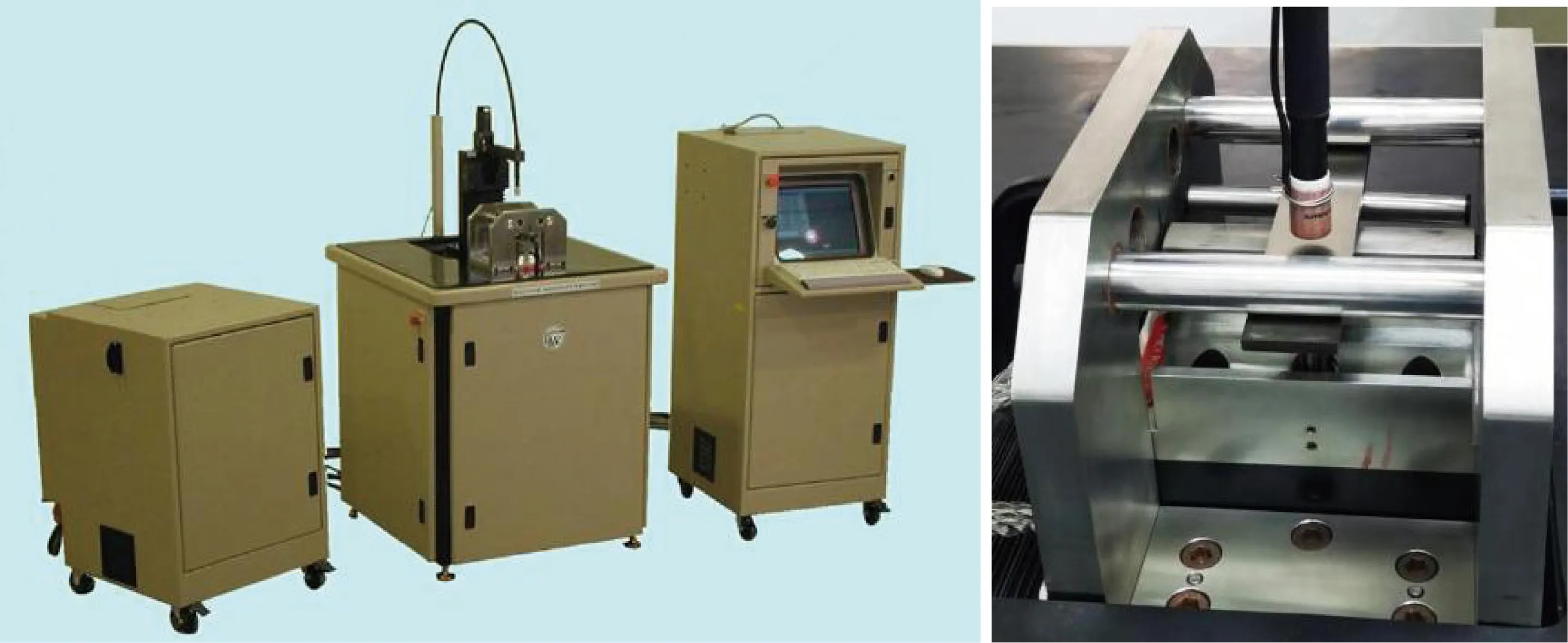
Fig.3 MTV2500 Varestraint test machine
In the Varestraint test,when the applied strain is higher than a critical value (named as the saturation strain),the MCL no longer increases with an increase in strain.At this time,hot cracking has expanded to the entire cracking susceptibility area.The MCL corresponding to the saturation strain value can be easily measured.Therefore,the temperature range corresponding to the maximum crack propagation path in the fusion zone and the HAZ can be calculated from the temperature difference between the solid-liquid interface of the molten pool and the crack propagation terminal temperature,as shown in Fig.4.In this study,the temperature range CSR corresponding to hot cracking growth is calculated by numerical simulation of the temperature field.
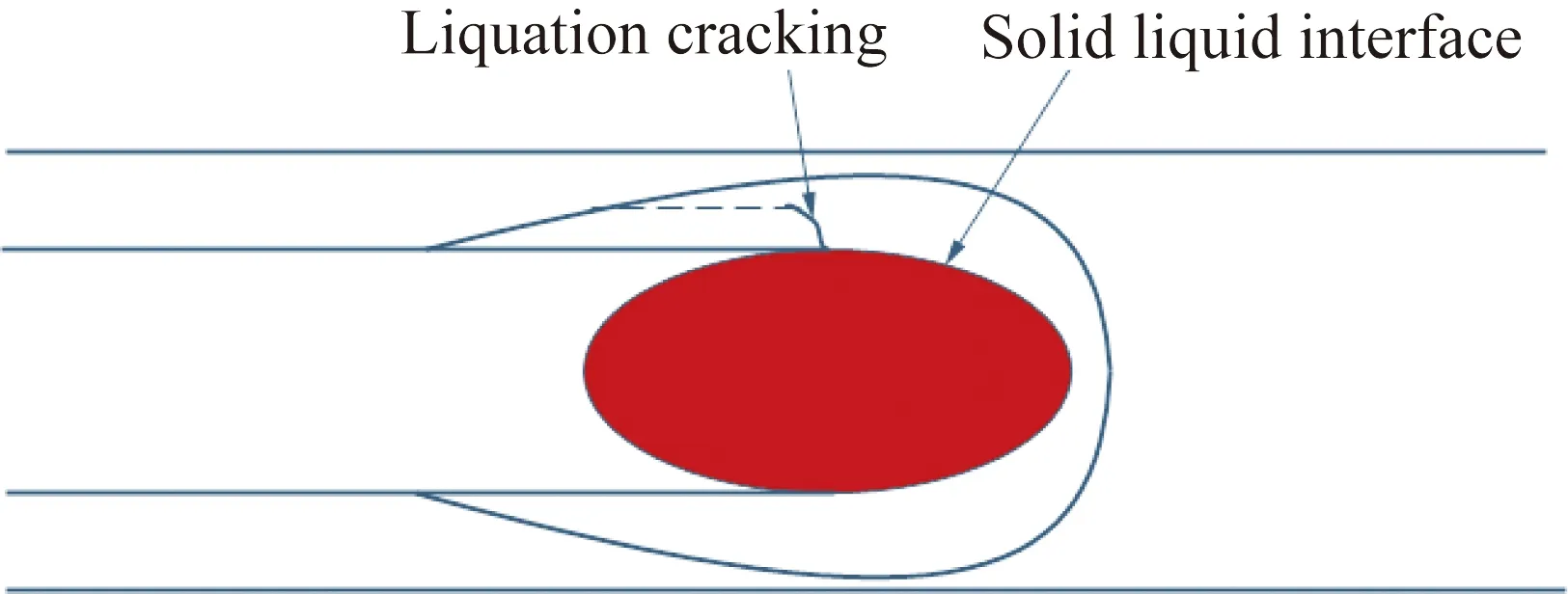
Fig.4 Thermal crack-susceptible region
3 Test results and analysis
For BTW1 austenitic high-manganese wear-resistant steel,a quantitative analysis of hot cracking and the welding parameters for TIG in the longitudinal Varestraint test are shown in Table 3.No surface cracks were found under strain conditions of 0.25%,0.5%,1%,and 2%.When the test strain reaches 3%,hot cracking begins to appear,and when the strain reaches 5%,the MCL reaches a saturated state.The MCL under 5% strain was observed,and it corresponded to the simulated calculated temperature field,and the thermal CSR of austenitic high-manganese wear-resistant steel was obtained.Fig.5 shows the thermal CSR of BTW1 austenitic high-manganese wear-resistant steel.Curve A in Fig.5 is the temperature cycle curve at the edge of the molten pool,and curve B is the temperature cycle curve corresponding to the maximum crack growth tip.Under the action of 5% strain,the largest crack produced will expand from pointsAtoBin the figure.The thermal CSR corresponding to the expansion path is calculated from the temperature difference between curves A and B at the loading time,that is,the difference between the actual solidification temperature corresponding to pointAof 1 339.2 ℃ and the temperature corresponding to the longest crack tip of 1 187.0 ℃.The hot cracking susceptibility evaluation results show that the critical strain of BTW1 austenitic high-manganese wear-resis-tant steel is 3%,and the thermal CSR is 152.2 K,as shown in Table 4.

Table 3 Welding parameters for TIG
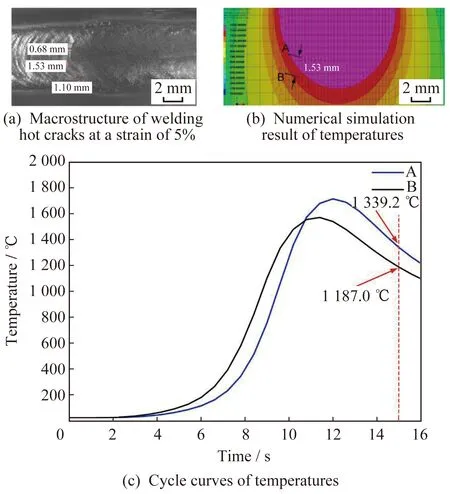
Fig.5 Thermal CSR of BTW1

MCL/mmCritical strain(εmin)/%Thermal CSR/KActual freezing temperature/℃1.523152.21 339.2
For steel with an austenitic matrix,the MCL corresponds to CSR,which is closely related to the metallurgical properties of the material.εmincharacterizes the difficulty of initiating hot cracking in a material,which is related to the metallurgical factors of the material and welding process conditions.Generally,the smaller theεmin,the higher the susceptibility of hot cracking.By controlling the content of impurity elements and grain growth,the tendency of hot cracking is reduced.Theεminof BTW1 austenitic high-manganese wear-resistant steel reaches 3%,which has a smaller tendency of hot cracking under small strain conditions in practical applications.
According to the material characteristics of BTW1 austenitic high-manganese wear-resistant steel and industrial application conditions,ER307Si high-manganese stainless steel metal inert gas(MIG) welding wire was used as the matching welding material to complete the test study of the welding process of BTW1 steel.The composition of the welding wire is shown in Table 5.Table 6 presents the welding test process parameters.A medium-thick plate of BTW1 austenitic high-manganese wear-resistant steel is used in typical wear-resistant fields such as coal mine machinery.The developed welding process uses high-manganese stainless steel welding materials and does not need preheat treatment before welding and elimination after welding.The elimination of the heat treatment pro-cess saves construction costs,significantly improves welding efficiency,reduces the difficulty of weld-ing,and is conducive to the industrialization of construction sites.BTW1 austenitic high-manganese wear-resistant steel is controlled by the composition of impurities,and the content of harmful impurities such as sulfur and phosphorus is low in this stell,which can prevent the formation of liquefied film in HAZ.In addition,the degree of grain coarsening in the HAZ of BTW1 is relatively low,and small grains increase the grain boundary area and reduce the degree of segregation and local stress on a single grain boundary.Since more damage occurs on grain boundaries,smaller grains further increase HAZ liquation cracking resistance.Through the multi-layer and multi-pass welding process,the inter-pass temperature is controlled to be lower than 150 ℃ to avoid excessive heat input that elongates the high-temperature residence time in HAZ,and a steep temperature gradient is generated in the HAZ,effectively avoiding the occurrence of hot cracking.No hot cracking was found in the fusion zone and its adjacent HAZ of BTW1 austenitic high-manganese wear-resistant steel welded joint,as shown in Fig.6.The degree of grain coarsening in the HAZ is relatively low (as shown in Fig.7),which can effectively reduce the influence of hot cracking susceptibility and ensure good welding quality.The performance test results of the welded test plate show that the welded joint has good tensile properties;the HAZ has good impact toughness and a large reserve of plasticity and toughness,which can meet the needs of engineering applications.The mechanical properties of the welded joint are shown in Table 7.

Table 5 Chemical composition of ER307Si stainless steel filler wire %

Table 6 Welding parameters for MIG welding of the BTW1
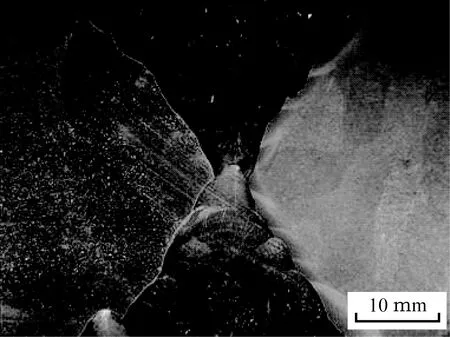
Fig.6 Weld morphologies of BTW1
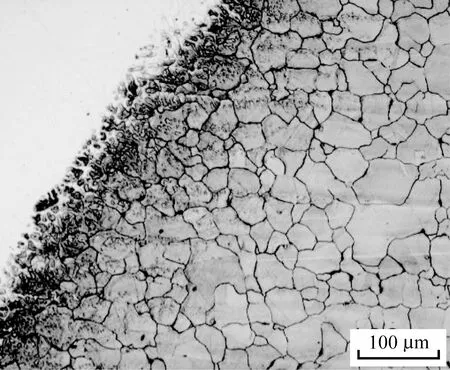
Fig.7 Microstructure of BTW1 HAZ

Table 7 Mechanical properties of the welded joint
4 Conclusions
(1) The Varestraint test is used as a quantitative evaluation method for hot cracking susceptibility of BTW1 austenitic high-manganese wear-resistant steel,and hot cracking susceptibility quantitative analysis data can be obtained,which can effectively support the application of such new wear-resistant steel materials.
(2) BTW1 austenitic high-manganese wear-resis-tant steel reduces the tendency of hot cracking susceptibility by controlling the content of harmful impurity elements and grain refinement and has a smaller tendency of hot cracking under small strain conditions in practical applications.
(3) Aiming at the typical wear-resistant applica-tion field of BTW1 austenitic high-manganese wear-resistant steel medium and thick plates,the devel-oped matching welding process can effectively avoid the influence of hot cracking susceptibility and meet the needs of engineering applications.
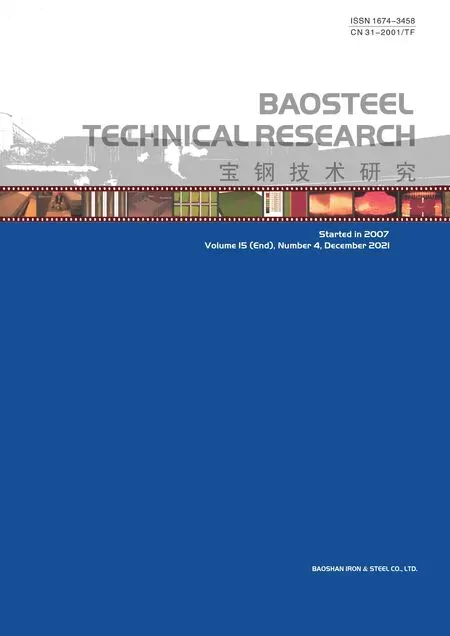 Baosteel Technical Research2021年4期
Baosteel Technical Research2021年4期
- Baosteel Technical Research的其它文章
- Influence of shielding gas on the transfer behavior of droplets
- Microstructure and properties of laser-arc hybrid welding of high-strength low-alloy steel
- Research status of corrosion environment failure and safety assessment of pipeline welded joint
- Analysis of inclusions and precipitates in tough weld metal of X80 steel
- Influence of different microstructural features on impact toughness and crack initiation behavior of coarse grain heat-affected zone in X80 pipeline steel
- Preface
